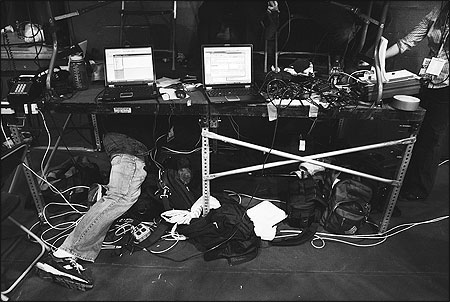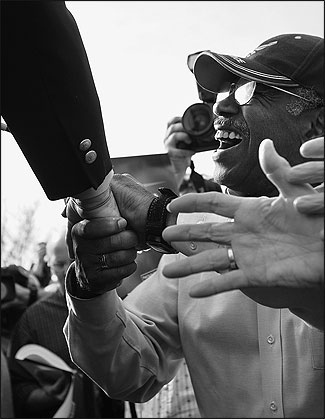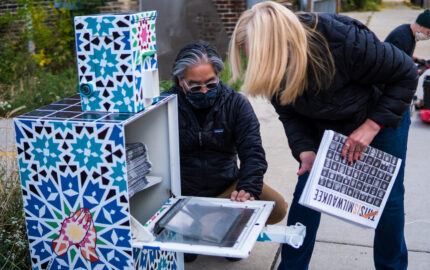
In one newsroom, the office manager recently moved a printer fewer than 50 feet to a more central location. The move brought squeals of protest. Something had changed. The printer stayed in its new location, albeit with plenty of grumbling.
It is within this kind of climate that newspapers confront enormous pressures to adapt to the rapidly and radically changing news and business environment. We wish!
Newsrooms, large and small, are busily remaking themselves with new committees and consultants and job titles, with rearrangements of desks and floor plans and modifications of workflow, and with organizational charts with titles and functions the likes of which have never been seen. Will newspapers transform themselves? Will they change the newsroom culture? Will all that's happening save the newsroom? We're hopeful, because we have to be. But perhaps the only thing we can be certain about is that change is coming fast.
In some cases, change arrives in the form of "radical innovations," the kind favored by General Electric's Jack Welch, who said, "You've got to constantly produce more for less through intellectual capital. Shun the incremental and look for the quantum leap." In other instances, change is merely new paint on rotted wood.
But in addition to Welch's notion of systemic radical change, there is also the idea of what I call "instant innovation." In this, newsroom managers need to create a climate of change in which innovations can be implemented on the fly, at little cost, and with low risk, even if they fail. And when such changes are successful, they will bring palpable improvements to the news product, such as what happened when we tried something different with our election coverage. (More on this soon.)
Michael Schrage, a research associate at MIT's Media Lab and author of "Serious Play: How the World's Best Companies Simulate to Innovate," calls this approach "disruptive incremental innovation." Examples of this include cartoonist Scott Adams's early use of his e-mail address on his Dilbert comic strip, which proved brilliantly innovative because fans then sent Adams ideas. "Getting your fans to subsidize your creativity — for free! — is an enviably efficient business model, Schrage wrote in a 2004 MIT Technology Review article. Other examples include:
- Apple's realization that how a computer looked mattered and gave the iMac a stylish look. The iMac wasn't technologically innovative, but customers thought the design was, and it became a hit product for Apple and forced beige box makers to play catch-up in aesthetics.
- James Dyson's idea to make the housings of his vacuum cleaners transparent. "While the costs of transparency were minimal, its perceived customer benefits were immense. Customer research affirmed that being able to see how well the Dyson cleaned was a valuable feature. Transparency profoundly differentiated Dyson from its competition — a classic disruptively incremental innovation," Schrage wrote.
In each case, while the changes were small or inexpensive, there was a big idea behind them — Adams' feedback of ideas, Apple's idea that people will pay a premium for style and, in Dyson's vacuum, seeing is believing. But the question remains: How do Dilbert, the iMac, and fancy vacuums better journalism? They don't. But creating an environment where journalists are encouraged to try instant innovations, along the line of Schrage's disruptive incremental innovation, most certainly will.

Political News: Trying Something New
Here's what happened at the Knoxville News Sentinel just before the presidential primary in Tennessee in February — an idea that any newspaper could do today.
RELATED ARTICLE
“Linking Newspaper Readers to the Best Political Coverage”
– Scott KarpThe idea was elegantly simple: supplement presidential campaign coverage with links to other content. Such linking to other news organizations' content would be considered by many a disruptive idea, but there was a further twist that, to my mind, made it a truly disruptive incremental innovation. The links we used would be selected by a group of people — most of them bloggers not affiliated with the newspaper — using a tool that made collaborative linking possible. The results automatically fed into a page on our Web site, www.knoxnews.com.
Here's what it took to make this happen:
- Number of sit-down meetings: None.
- Number of conference calls: None.
- Number of contracts or releases: None.
- From concept to execution: A couple of days.
After I'd been experimenting with Karp's Publish2 site (www.Publish2.com) as a links-as-content-building tool for a few weeks, Karp suggested the presidential primary might hold the potential to utilize his fledgling platform's collaborative capabilities. We settled on political bloggers as the group who could best do the collaborative linking, because they are a) passionate about politics, b) ferocious readers of political news, and c) could likely handle installing the link-building tool and using a Web site then still in private beta. And News Sentinel reporter and blogger Michael Silence agreed to see if he could roundup a group of willing Tennessee bloggers across the political spectrum.
For the most part, the bloggers Silence contacted had never heard of Publish2 or Scott Karp, or were not even quite sure what the newspaper was up to. But, amazingly, almost no one who was asked declined. In fact, the first to implement the headline feed was not the newspaper but Randy Neal, who runs several community blogging sites in Knoxville. Seemingly within minutes of getting the RSS link to our headline feed, he had it in the sidebar of his Drupal-powered TennViews.com site.
Once the collaborative links were up on our Web site, we found that they ranged from mainstream media articles from across the country to blogger postings. And since this effort involved the work of several people, the headlines flowed through rapidly at times, creating an organic flow of news from people who know their politics and their political news. They were finding what we like to call "the keepers," and we were bringing them to our readers. Here are some of those bookmarked headlines and where they came from:
- "In Tennessee, Thompson Still Counts," Time.com
- "Text your picks to the polls," Cyberjournalist.com and Los Angeles Times
- "Rep. Cohen Endorses Obama; So Does Local Democratic Chairman," Memphis Flyer, Politics Buzz, and Politics
- "STICKY: Knox County Primaries: Yes, there are local races!," KnoxViews
- "Flip-Flop, Flip-Flop" Progressive Nashville
- "For Once I'm the Undecided Voter," "Where's the Mute Button?"
- "An Open Post-It Note To Card-Carrying Republicans," Hear ItFrom.Us
The link we gave readers to this new page of headline links was part of our front page election block of links at www.knoxnews.com. And several of the bloggers involved wrote about the effort, as did some other bloggers.
Were these people working for free for the newspaper? Well, maybe, but no one "owned" the resulting news product. Our collaborators were free to use the headline feed in any way they wanted. The newspaper's role was only in pulling together a group of experts for a common task. I call that a win-win — and an insanely disruptive instant innovation.
Other experiments with aggregating such links-as-news have convinced me that the process of selecting high-quality content can be as valuable to the reader as original content creation. A good collection of links should not only be relegated to the "See related" box, but also featured on the newspaper's Web site.
Was this primary election night effort of ours a huge traffic driver? No, it did not make it into our top stories of the day. But lists of links on more locally focused topics have been among our more popular Web items. What it did demonstrate to me was its potential, and with the right packaging I know it could be very successful. And while this experiment was aimed at covering the presidential campaigns up to when the Tennessee primary took place, we hope to revive this group for the fall election. In the meantime, we're looking for other ways to "disrupt" with this idea — and I'm urging others to do this, too.
This is but one example of an instant innovation. If you have others, I'd love to hear them. Please e-mail me at jack@jacklail.com.
Jack Lail is managing editor/multimedia for the Knoxville (Tenn.) News Sentinel and its family of Web sites that include knoxnews.com and Go-VolsXtra.com.



